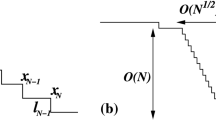Abstract
In this paper, we introduce different forms of mobility into a quantitative phase-field model to produce arbitrary Ehrlich-Schwoebel (ES) effects. Convergence studies were carried out in the one-side step-flow model, which showed that the original mobility not only induces the ES effect, but also leads to larger numerical instability with increase of the step width. Thus, another modified form of the ES barrier is proposed, and is found to be more suitable for large-scale simulations. Model applications were performed on the wedding-cake structure, coarsening and coalescence of islands and spiral growth. The results show that the ES barrier exhibits more significant kinetic effects at the larger deposition rates by limiting motions of atoms on upper steps, leading to aggregation on the top layers, as well as the roughening of growing surfaces.
Similar content being viewed by others
References
Cho A Y, Arthur J R. Molecular beam epitaxy. Prog Solid State Chem, 1975, 10: 157–191
Herman M A, Sitter H. Molecular Beam Epitaxy: Fundamentals and Current Status. Berlin: Springer-Verlag Press, 2012. 29–42
Panish M B. Molecular beam epitaxy. Science, 1980, 208: 916–922
Springholz G, Ueta A Y, Frank N, et al. Spiral growth and threading dislocations for molecular beam epitaxy of PbTe on BaF2 (111) studied by scanning tunneling microscopy. Appl Phys Lett, 1996, 69: 2822–2824
Chen S, Merriman B, Kang M, et al. A level set method for thin film epitaxial growth. Physics, 2001, 167: 475–500
Amar J G, Family F. Critical cluster size: Island morphology and size distribution in submonolayer epitaxial growth. Phys Rev Lett, 1995, 74: 2066–2069
Nurminen L, Kuronen A, Kaski K. Kinetic Monte Carlo simulation of nucleation on patterned substrates. Phys Rev B, 2000, 63: 035407-1–7
Wang L G, Clancy P. Kinetic Monte Carlo simulation of Cu thin film growth. Surf Sci, 2001, 473: 25–38
Voronkov V V. The movement of an elementary step by means of the formation of one-dimensional nuclei. Phys Cryst, 1970, 15: 8–13
Lam C H, Lee C K, Sander L M. Competing roughening mechanisms in strained heteroepitaxy: A fast kinetic Monte Carlo study. Phys Rev Lett, 2002, 89: 216102-1–4
Caflisch R E, Weinan E, Gyure M F, et al. Kinetic model for a step edge in epitaxial growth. Phys Rev E, 1999, 59: 6879–6887
Burton W K, Cabrera N, Frank F C, et al. The growth of crystals and the equilibrium structure of their surfaces. Trans R Soc London Ser A, 1951, 243: 299–358
Ratz A, Voigt A. Phase-field model for island dynamics in epitaxial growth. Appl Anal, 2004, 83: 1015–1025
Otto F, Penzler P, Ratz A, et al. A diffuse-interface approximation for step flow in epitaxial growth. Nonlinearity, 2004, 17: 477–491
Ehrlich G, Hudda F G, Chem J. Atomic view of surface selfdiffusion: Tungsten on Tungsten. Physics, 1966, 44: 1039–1049
Schwoebel R L. Step motion on crystal surfaces. II. Appl Phys, 1969, 40: 614–618
Liu F, Metiu H. Stability and kinetics of step motion on crystal surfaces. Phys Rev E, 1994, 49: 2601–2615
Pierre-Louis O. Phase field models for step flow. Phys Rev E, 2003, 68: 021604-1–19
Karma A, Plapp M. Spiral surface growth without desorption. Phys Rev Lett, 1998, 81: 4444–4447
Redinger A, Ricken O, Kuhn P, et al. Spiral growth and Step edge barriers. Phys Rev Lett, 2008, 100: 035506-1–4
Ratsch C, Venables J A, Vac J. Nucleation theory and the early stages of thin film growth. Sci Technol A, 2003, 21: S96–S106
Evans J W, Thiel P A, Bartelt M C. Morphological evolution during epitaxial thin film growth: Formation of 2D islands and 3D mounds. Surf Sci Rep, 2006, 61: 118–128
Einax M, Dieterich W, Maass P. Colloquium: Cluster growth on surfaces: Densities, size distributions, and morphologies. Rev Mod Phys, 2013, 85: 921–939
Provatas N, Elder K. Phase-Field Methods in Materials Science and Engineering. Weinheim: Wiley Press, 2010
Karma A, Rappel W J. Quantitative phase-field modeling of dendritic growth in two and three dimensions. Phys Rev E, 1998, 57: 4323–4349
Yu Y M, Liu B G. Phase-field model of island growth in epitaxy. Phys Rev E, 2004, 69: 021601-1–6
Yu Y M, Liu B G. Self-organized formation of regular nanostripes on vicinal surfaces. Phys Rev B, 2004, 70: 205414-1–7
Yu Y M, Liu B G. Contrasting morphologies of O-rich ZnO epitaxy on Zn- and O-polar thin film surfaces: Phase-field model. Phys Rev B, 2008, 77: 195327-1–6
Yu Y M, Liu B G. Coexistence of meandering and bunching of steps on vicinal surfaces. Phys Rev B, 2006, 73: 035416-1–5
Hu Z, Lowengrubb J S, Wisec S M, et al. Phase-field modeling of epitaxial growth: Applications to step trains and island dynamics. Physica D, 2012, 241: 77–94
Michely T, Krug J. Islands, Mounds and Atoms: Patterns and Processesin Crystal Growth Far from Equilibrium. Berlin: Springer Press, 2004
Pierre-Louis O, Danker G, Chang J, et al. Nonlinear dynamics of vicinal surfaces. Cryst Growth, 2005, 275: 56–64
Misbah C, Pierre-Louis O, Saito Y. Crystal surfaces in and out of equilibrium: A modern view. Rev Mod Phys, 2010, 82: 981–1040
Echebarria B, Folch R, Karma A, et al. Quantitative phase-field model of alloy solidification. Phys Rev E, 2004, 70: 061604-1–22
Author information
Authors and Affiliations
Corresponding author
Rights and permissions
About this article
Cite this article
Dong, X., Xing, H., Sha, S. et al. Phase-field modeling of epitaxial growth with the Ehrlich-Schwoebel barrier: Model validation and application. Sci. China Technol. Sci. 58, 753–762 (2015). https://doi.org/10.1007/s11431-015-5778-3
Received:
Accepted:
Published:
Issue Date:
DOI: https://doi.org/10.1007/s11431-015-5778-3




